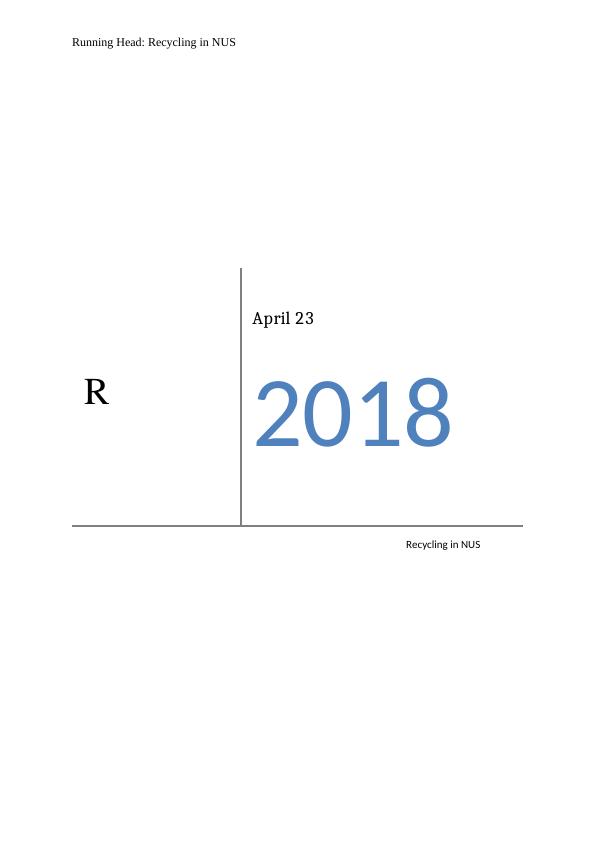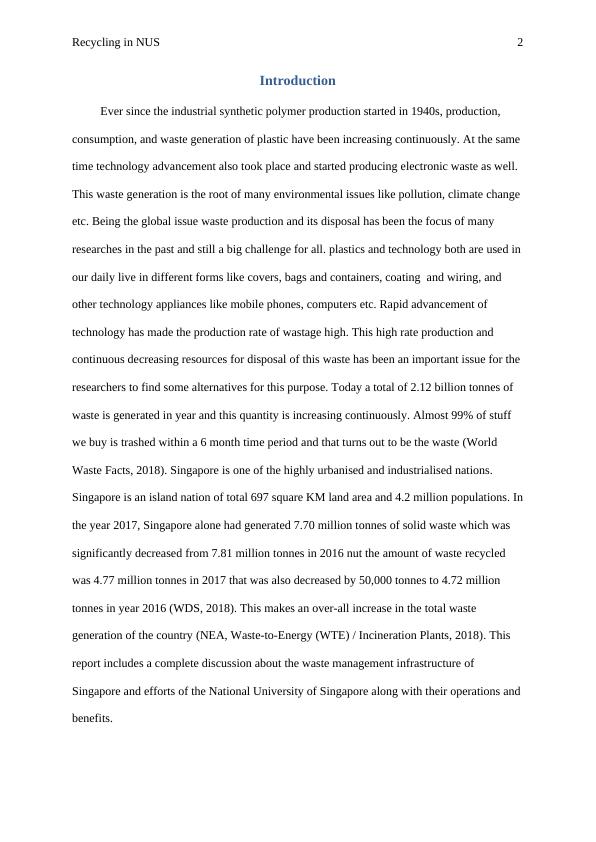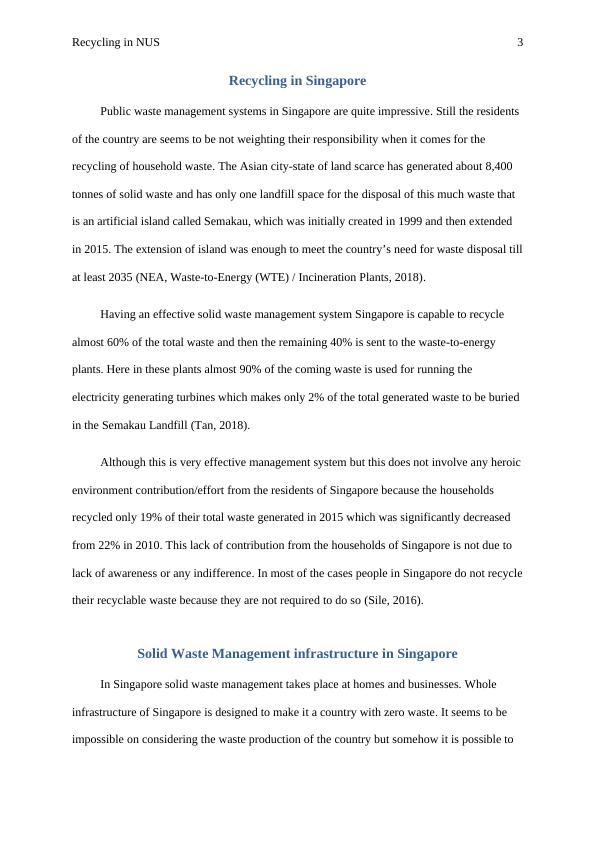Recycling in NUS: Waste Management Infrastructure and Initiatives
Added on 2023-06-12
16 Pages3899 Words419 Views
Running Head: Recycling in NUS
April 23
2018
Recycling in NUS
April 23
2018
Recycling in NUS

Recycling in NUS 1
Contents
Introduction................................................................................................................................2
Recycling in Singapore..............................................................................................................3
Solid Waste Management infrastructure in Singapore...............................................................3
Collection and sorting............................................................................................................4
Waste-to-energy plants...........................................................................................................5
Tuas Marine Transfer Station.................................................................................................5
Semakau Landfill...................................................................................................................5
Development of integrated waste management facility (IWMF)..........................................6
Recycling in NUS......................................................................................................................6
Measures of successful recycling in NUS..................................................................................6
Recycling of paper, metal and plastics...................................................................................7
Recycling of glass..................................................................................................................7
Recycle-A-Bulb......................................................................................................................7
Green wardrobes for Reuse/Recycling of clothes..................................................................8
Save that pen..........................................................................................................................8
Associated costs of recycling.....................................................................................................9
Conclusion................................................................................................................................11
Contents
Introduction................................................................................................................................2
Recycling in Singapore..............................................................................................................3
Solid Waste Management infrastructure in Singapore...............................................................3
Collection and sorting............................................................................................................4
Waste-to-energy plants...........................................................................................................5
Tuas Marine Transfer Station.................................................................................................5
Semakau Landfill...................................................................................................................5
Development of integrated waste management facility (IWMF)..........................................6
Recycling in NUS......................................................................................................................6
Measures of successful recycling in NUS..................................................................................6
Recycling of paper, metal and plastics...................................................................................7
Recycling of glass..................................................................................................................7
Recycle-A-Bulb......................................................................................................................7
Green wardrobes for Reuse/Recycling of clothes..................................................................8
Save that pen..........................................................................................................................8
Associated costs of recycling.....................................................................................................9
Conclusion................................................................................................................................11

Recycling in NUS 2
Introduction
Ever since the industrial synthetic polymer production started in 1940s, production,
consumption, and waste generation of plastic have been increasing continuously. At the same
time technology advancement also took place and started producing electronic waste as well.
This waste generation is the root of many environmental issues like pollution, climate change
etc. Being the global issue waste production and its disposal has been the focus of many
researches in the past and still a big challenge for all. plastics and technology both are used in
our daily live in different forms like covers, bags and containers, coating and wiring, and
other technology appliances like mobile phones, computers etc. Rapid advancement of
technology has made the production rate of wastage high. This high rate production and
continuous decreasing resources for disposal of this waste has been an important issue for the
researchers to find some alternatives for this purpose. Today a total of 2.12 billion tonnes of
waste is generated in year and this quantity is increasing continuously. Almost 99% of stuff
we buy is trashed within a 6 month time period and that turns out to be the waste (World
Waste Facts, 2018). Singapore is one of the highly urbanised and industrialised nations.
Singapore is an island nation of total 697 square KM land area and 4.2 million populations. In
the year 2017, Singapore alone had generated 7.70 million tonnes of solid waste which was
significantly decreased from 7.81 million tonnes in 2016 nut the amount of waste recycled
was 4.77 million tonnes in 2017 that was also decreased by 50,000 tonnes to 4.72 million
tonnes in year 2016 (WDS, 2018). This makes an over-all increase in the total waste
generation of the country (NEA, Waste-to-Energy (WTE) / Incineration Plants, 2018). This
report includes a complete discussion about the waste management infrastructure of
Singapore and efforts of the National University of Singapore along with their operations and
benefits.
Introduction
Ever since the industrial synthetic polymer production started in 1940s, production,
consumption, and waste generation of plastic have been increasing continuously. At the same
time technology advancement also took place and started producing electronic waste as well.
This waste generation is the root of many environmental issues like pollution, climate change
etc. Being the global issue waste production and its disposal has been the focus of many
researches in the past and still a big challenge for all. plastics and technology both are used in
our daily live in different forms like covers, bags and containers, coating and wiring, and
other technology appliances like mobile phones, computers etc. Rapid advancement of
technology has made the production rate of wastage high. This high rate production and
continuous decreasing resources for disposal of this waste has been an important issue for the
researchers to find some alternatives for this purpose. Today a total of 2.12 billion tonnes of
waste is generated in year and this quantity is increasing continuously. Almost 99% of stuff
we buy is trashed within a 6 month time period and that turns out to be the waste (World
Waste Facts, 2018). Singapore is one of the highly urbanised and industrialised nations.
Singapore is an island nation of total 697 square KM land area and 4.2 million populations. In
the year 2017, Singapore alone had generated 7.70 million tonnes of solid waste which was
significantly decreased from 7.81 million tonnes in 2016 nut the amount of waste recycled
was 4.77 million tonnes in 2017 that was also decreased by 50,000 tonnes to 4.72 million
tonnes in year 2016 (WDS, 2018). This makes an over-all increase in the total waste
generation of the country (NEA, Waste-to-Energy (WTE) / Incineration Plants, 2018). This
report includes a complete discussion about the waste management infrastructure of
Singapore and efforts of the National University of Singapore along with their operations and
benefits.

Recycling in NUS 3
Recycling in Singapore
Public waste management systems in Singapore are quite impressive. Still the residents
of the country are seems to be not weighting their responsibility when it comes for the
recycling of household waste. The Asian city-state of land scarce has generated about 8,400
tonnes of solid waste and has only one landfill space for the disposal of this much waste that
is an artificial island called Semakau, which was initially created in 1999 and then extended
in 2015. The extension of island was enough to meet the country’s need for waste disposal till
at least 2035 (NEA, Waste-to-Energy (WTE) / Incineration Plants, 2018).
Having an effective solid waste management system Singapore is capable to recycle
almost 60% of the total waste and then the remaining 40% is sent to the waste-to-energy
plants. Here in these plants almost 90% of the coming waste is used for running the
electricity generating turbines which makes only 2% of the total generated waste to be buried
in the Semakau Landfill (Tan, 2018).
Although this is very effective management system but this does not involve any heroic
environment contribution/effort from the residents of Singapore because the households
recycled only 19% of their total waste generated in 2015 which was significantly decreased
from 22% in 2010. This lack of contribution from the households of Singapore is not due to
lack of awareness or any indifference. In most of the cases people in Singapore do not recycle
their recyclable waste because they are not required to do so (Sile, 2016).
Solid Waste Management infrastructure in Singapore
In Singapore solid waste management takes place at homes and businesses. Whole
infrastructure of Singapore is designed to make it a country with zero waste. It seems to be
impossible on considering the waste production of the country but somehow it is possible to
Recycling in Singapore
Public waste management systems in Singapore are quite impressive. Still the residents
of the country are seems to be not weighting their responsibility when it comes for the
recycling of household waste. The Asian city-state of land scarce has generated about 8,400
tonnes of solid waste and has only one landfill space for the disposal of this much waste that
is an artificial island called Semakau, which was initially created in 1999 and then extended
in 2015. The extension of island was enough to meet the country’s need for waste disposal till
at least 2035 (NEA, Waste-to-Energy (WTE) / Incineration Plants, 2018).
Having an effective solid waste management system Singapore is capable to recycle
almost 60% of the total waste and then the remaining 40% is sent to the waste-to-energy
plants. Here in these plants almost 90% of the coming waste is used for running the
electricity generating turbines which makes only 2% of the total generated waste to be buried
in the Semakau Landfill (Tan, 2018).
Although this is very effective management system but this does not involve any heroic
environment contribution/effort from the residents of Singapore because the households
recycled only 19% of their total waste generated in 2015 which was significantly decreased
from 22% in 2010. This lack of contribution from the households of Singapore is not due to
lack of awareness or any indifference. In most of the cases people in Singapore do not recycle
their recyclable waste because they are not required to do so (Sile, 2016).
Solid Waste Management infrastructure in Singapore
In Singapore solid waste management takes place at homes and businesses. Whole
infrastructure of Singapore is designed to make it a country with zero waste. It seems to be
impossible on considering the waste production of the country but somehow it is possible to

End of preview
Want to access all the pages? Upload your documents or become a member.
Related Documents
The Process of Waste to Energy Conversion Assignment 2022lg...
|6
|1106
|25
Attitudes and Behaviours in Reducing Plastic Wasteslg...
|10
|2563
|22
Solid Waste Management in Sydneylg...
|13
|2671
|394
Plastics in the Environment - PDFlg...
|8
|749
|68
Plastic Bags: Environmental Impact and Recyclinglg...
|5
|792
|453
Improper Waste Disposal: Influences, Interventions, and Strategieslg...
|15
|3955
|42
